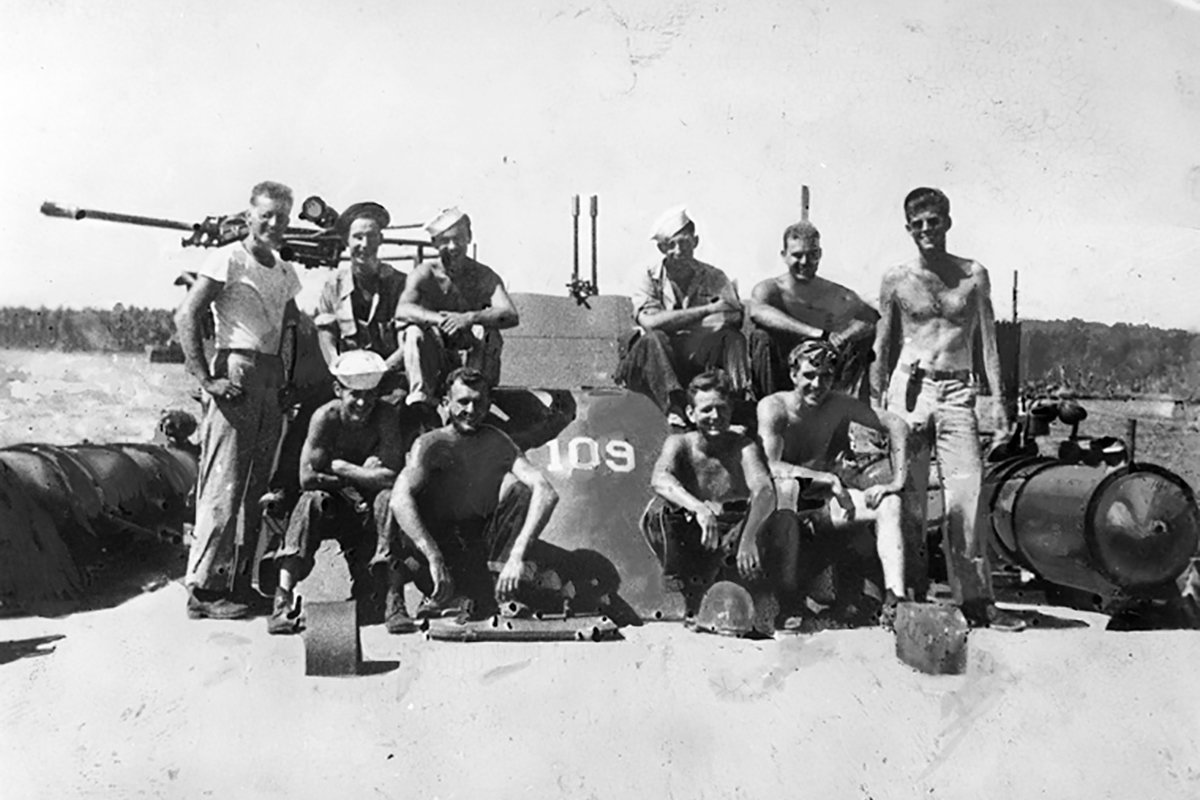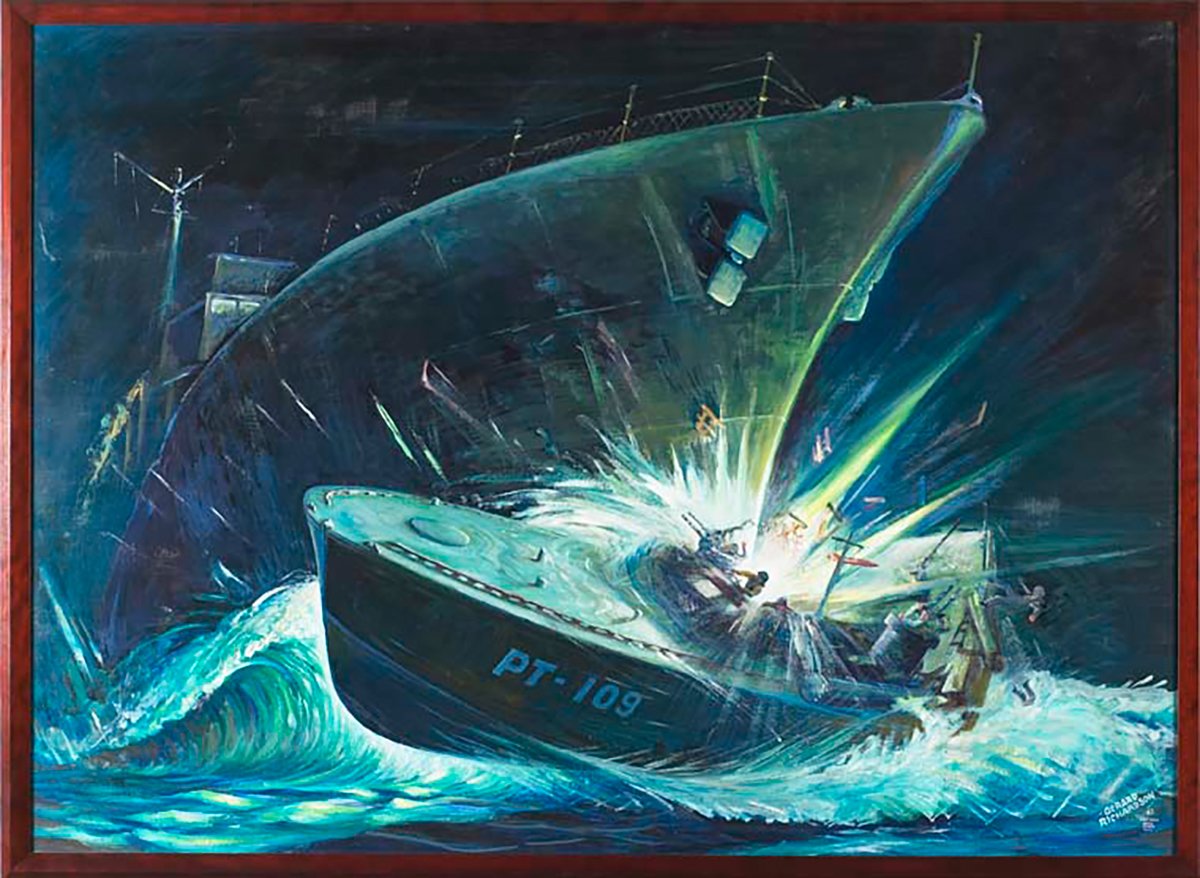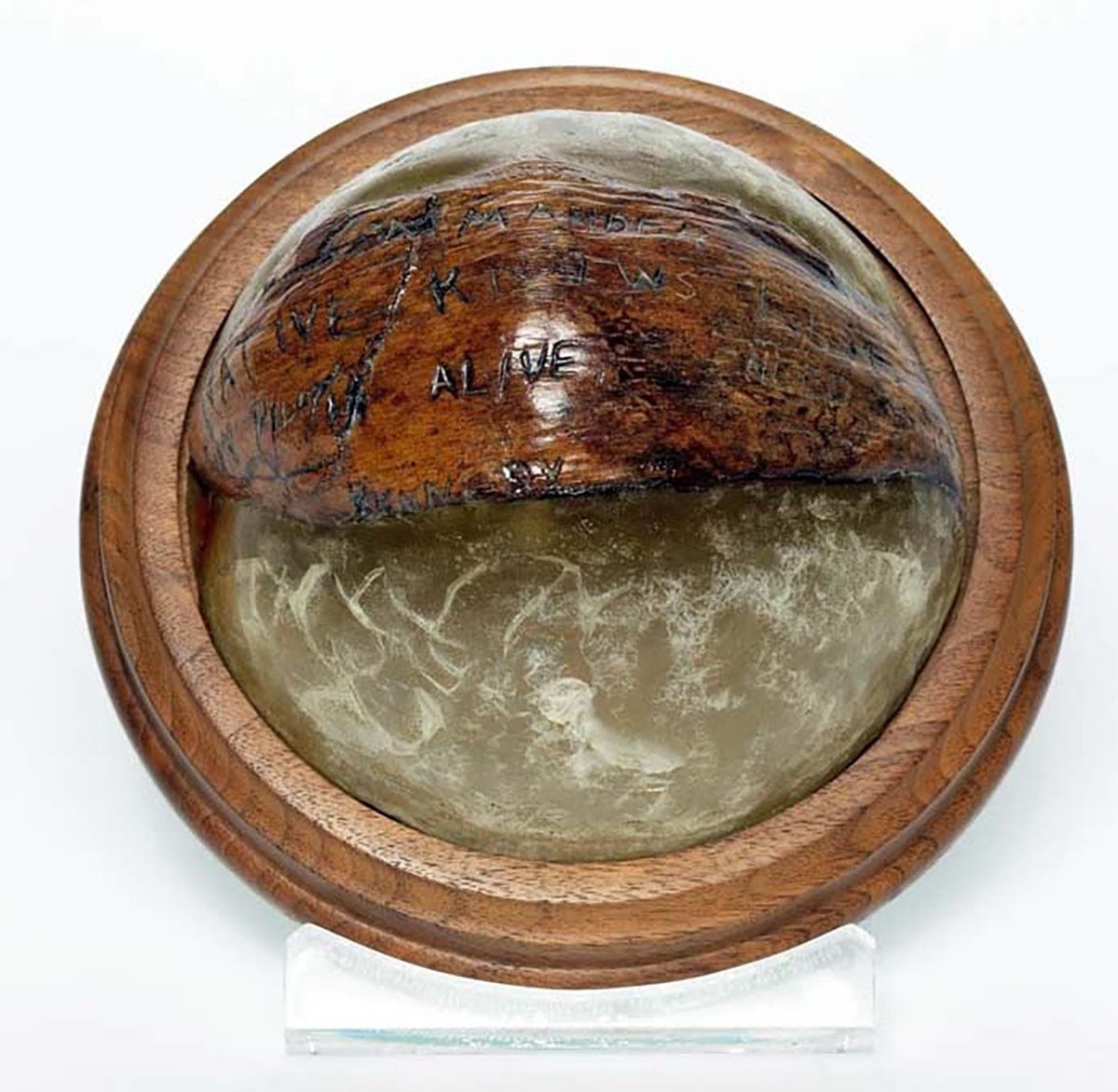How a ‘Coconut Message’ Rescued a Shipwrecked JFK During World War II

John F. Kennedy and the crew of PT-109 in the Solomon Islands in 1943. Back row, left to right: Allan Webb, Leon Drawdy, Edgar Mauer, Edmund Drewitch, John Maguire, Lt. j.g. John F. Kennedy. Front row, left to right: Charles Harris, Maurice Kowal, Andrew Kirksey, and Lenny Thom. Photo courtesy of the John F. Kennedy Presidential Library and Museum.
During World War II, 26-year-old John F. Kennedy was nearly killed in action when a Japanese destroyer collided with his patrol torpedo boat in the South Pacific. The harrowing encounter stretched into an eight-day saga that ended with two heroism awards and a coconut souvenir Kennedy later displayed in the Oval Office while serving as the 35th president of the United States.
On the moonless, starless night of Aug. 1, 1943, PT-109 was one of 15 patrol torpedo boats in the Blackett Strait, south of Kolombangara in the Solomon Islands. While PT-109 ran silent to avoid detection, the skipper at its helm, Kennedy — who was then a lieutenant junior grade — scanned the horizon. He searched and found the unmistakable “Tokyo Express,” the feared convoy of Japanese destroyers that escorted supplies and soldiers through the night to reach Guadalcanal. The patrol intercepted three Japanese battleships and one Japanese escort, firing 30 torpedoes in all, with none hitting their targets.
The order came to return to base. PT-109 and three other boats formed a line across the strait, covering their retreat. One of the PT boats, the only one with radar, took off after a Japanese target, leaving the other three blind. The skippers, fully aware the phosphorescent plankton in the tropical waters could turn their vessels’ wakes into glowing targets from the air, each chugged forward on the throttle of just one of three engines.

The next morning, around 2:30 a.m., a shape loomed out of the darkness, traveling fast at about 40 knots, on a collision course with PT-109. Kennedy and his 13 crew members believed it was another PT boat until the black hull of the Japanese destroyer Amagiri emerged into view.
Kennedy swung PT-109 right in a last-ditch attempt to bring its torpedoes in line, but there wasn’t enough time. In a matter of 10 seconds, the Amagiri rammed the American boat, cutting it in half. The impact threw Kennedy off his feet; he narrowly escaped the vessel’s damaged cockpit. Two sailors were killed instantly, while other members of the crew were flung into the water. While the Amagiri steamed away, its wake put out the flames. Five sailors, including Kennedy, clung to a floating section of the stricken PT boat.
Kennedy called out to the survivors and heard replies from six. He pinpointed Gunner’s Mate Charles Harris, who was badly wounded, and Motor Machinist Mate Patrick McMahon, who’d suffered burn injuries when the PT boat’s fuel tank exploded. Kennedy dove into the ocean, and although the men were only 100 yards from their boat, it took him three hours to rescue the two men in the dark. The survivors had a short discussion on what they should do next.

“There’s nothing in the book about a situation like this,” Kennedy later said. “A lot of you men have families and some of you have children. What do you want to do? I have nothing to lose.”
The decision was made, and all 11 survivors ditched the sinking vessel. They intended to swim to an island named Plum Pudding, located some 3.5 miles away. The distance was manageable for Kennedy, who had been on the Harvard swim team. But he also took on the arduous task of towing McMahon, holding McMahon’s belt in his teeth. Several of the other men were good swimmers, but two couldn’t swim at all — they had to be pushed and pulled along on a plank the entire distance.
Kennedy was the first to arrive at Plum Pudding. The survivors, however, called it “Bird Island” because of the bird droppings covering the bushes. McMahon had to help an exhausted Kennedy ashore, but the swimming ordeal was not yet over. After being spooked by a passing Japanese barge, Kennedy swam down to Ferguson Passage, an area frequented by American PT boats. He scampered across coral reefs and swam for more than an hour until he realized that rescue wasn’t coming that night. The return swim nearly killed him. Strong currents forced him to retire for the night at Leorava, an island located to the southeast of Bird Island.
For the next two days, the PT-109 survivors swam to nearby islands in search of fresh water and food. Kennedy and another survivor, Ensign George Ross, explored Naru Island, the last island in the chain. Naru’s eastern shore overlooked Ferguson Passage. The pair climbed onto the beach, careful to not alert any roving enemy patrols, and spotted a shipwreck. They found and searched a small box with Japanese labels, discovering Japanese candy inside. Small victories.

A little farther up the island, they found a one-man canoe stashed in the bushes. Then they spotted two islanders paddling away in a canoe. The next morning, Kennedy contacted the men, who were later identified as Biuku Gasa and Eroni Kumana — they were islander coast watchers for the Allies.
On Aug. 6, 1943, Kennedy carved a message into a green coconut that read, “NAURO ISL…COMMANDER…NATIVE KNOWS POS’IT…HE CAN PILOT…11 ALIVE…NEED SMALL BOAT…KENNEDY.”
He handed the coconut to the islanders and they went on their way. The next morning, the two men returned with a letter from Australian coast watcher commander Lt. A. Reginald Evans. The letter informed Kennedy to travel with the islanders to Gomu Island in Blackett Strait. The islanders hid Kennedy under a pile of palm leaves and paddled him to meet with Evans.
Six days after the sinking of PT-109, the hardest part was over. Kennedy insisted on having the two rescue boats, PT-157 and PT-171, rescue him first so he could guide them through the reefs and shallows. On the night of Aug. 7, Kennedy signaled the rescue boats with three shots from his revolver and a fourth from a rifle while standing in a canoe. He didn’t anticipate the recoil from the rifle and was knocked off balance, falling out of the little boat and into the water. PT-157 arrived at the rendezvous point and pulled Kennedy aboard.
On the morning of Aug. 8, the remaining PT-109 crew survivors were rescued. They reached the US base at Rendova at 5:30 a.m. The ordeal was finally over. Kennedy was awarded the Purple Heart and the Navy and Marine Corps Medal, the only US president to receive such honors. He was honorably discharged from the Navy in 1945.
In 1961, Bob Curran, an editor of American Cavalier magazine, read a story about Evans, the Australian coast watcher, and invited him to meet Kennedy at the White House. Evans had gone unrecognized for 17 years “because I couldn’t read his handwriting,” Kennedy explained. American newspapers, according to Curran, invented a Lt. Wincote of the New Zealand infantry because nobody wanted to expose the coast watchers’ operations in the Pacific theater. While Curran and Evans suggest the ordeal with PT-109 was likely a blunder on Kennedy’s part, the truth of the matter is lost to history.
Read Next: Heroism in the Deep: The 1939 Rescue of the USS Squalus

Matt Fratus is a history staff writer for Coffee or Die. He prides himself on uncovering the most fascinating tales of history by sharing them through any means of engaging storytelling. He writes for his micro-blog @LateNightHistory on Instagram, where he shares the story behind the image. He is also the host of the Late Night History podcast. When not writing about history, Matt enjoys volunteering for One More Wave and rooting for Boston sports teams.
BRCC and Bad Moon Print Press team up for an exclusive, limited-edition T-shirt design!
BRCC partners with Team Room Design for an exclusive T-shirt release!
Thirty Seconds Out has partnered with BRCC for an exclusive shirt design invoking the God of Winter.
Lucas O'Hara of Grizzly Forge has teamed up with BRCC for a badass, exclusive Shirt Club T-shirt design featuring his most popular knife and tiomahawk.
Coffee or Die sits down with one of the graphic designers behind Black Rifle Coffee's signature look and vibe.
Biden will award the Medal of Honor to a Vietnam War Army helicopter pilot who risked his life to save a reconnaissance team from almost certain death.
Ever wonder how much Jack Mandaville would f*ck sh*t up if he went back in time? The American Revolution didn't even see him coming.
A nearly 200-year-old West Point time capsule that at first appeared to yield little more than dust contains hidden treasure, the US Military Academy said.












